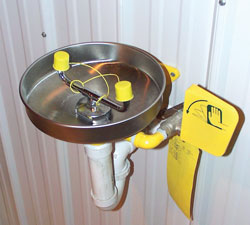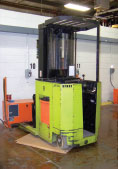
Help is Out There
Wash away the uncertainties of emergency eyewash/shower requirements
- By Becca Kandler
- May 01, 2009
 No one can predict when a chemical splash will occur. But we can plan for the possibility, put in place preventive and protective measures, and prepare for a quick emergency response.
No one can predict when a chemical splash will occur. But we can plan for the possibility, put in place preventive and protective measures, and prepare for a quick emergency response.
To combat the risk of chemical splashes and other exposures to hazardous substances, various hazard controls can be used. However, despite our best designs, sometimes employees need to work near hazardous substances, putting them at risk of being exposed. In theses situations, personal protective equipment is issued. However, if the protection supplied by PPE is breached, employees need to be able to remove the contaminant as quickly as possible. This is when the need for emergency eyewash and shower equipment becomes crucial. There are a lot of questions regarding where emergency eyewash/shower equipment is needed. It is little help that OSHA's requirements are limited and quite vague.
Basic Requirements
OSHA specifi cally requires emergency eyewash/ shower stations in a number of regulations, such as those for dipping and coating operations; medical services and first aid; pulp, paper, and paperboard mills; formaldehyde; and carcinogens. Unfortunately, there are no clear lists saying: Here you need them and here you don't. As a result, a thorough hazard assessment is necessary to determine whether eyewashes and/or showers are needed.
The general OSHA requirement for emergency eyewashes and showers is found at 29 CFR 1910.151(c). In this standard, OSHA specifies that "where the eyes or body of any person may be exposed to injurious corrosive materials, suitable facilities for quick drenching or flushing of the eyes and body shall be provided within the work area for immediate emergency use." As the standard states, an eyewash and/or safety shower would be required where an employee's eyes or body could be exposed to injurious corrosive materials. OSHA has said the Material Safety Data Sheet (MSDS) should be consulted when determining the need for emergency eyewash/shower equipment. OSHA expects the employer to determine the level of potential risk and provide protection accordingly.
Beyond requiring the equipment, OSHA does not provide a great deal of detail on eyewashes/ showers. However, where the regulations are silent, OSHA has referred us to the American National Standards Institute (ANSI) standard Z358.1 Emergency Eyewash and Shower Equipment for specific requirements.
While not having the force of a regulation under the OSH Act, the current ANSI standard (ANSI Z358.1-2004) requires eyewash and shower equipment in appropriate situations when employees are exposed to hazardous materials. The ANSI standard's definition of "hazardous material" would include caustics, as well as additional substances and compounds that have the capability of producing adverse effects on human health and safety.
Location, Location, Location
The first seconds after an exposure are critical. The location of eyewash equipment is important because eyes can be damaged very quickly. In 2008, federal OSHA issued 774 violations, with adjusted penalties totaling more than $300,000, for emergency eyewash/shower facilities not being in near proximity to employees.
Eyewashes should be located as close as possible to the hazard. The more hazardous the material, the closer the unit should be. The ANSI standard suggests that an eyewash and shower be no farther than a 10-second travel time from the hazard. For strong acids or caustics, the eyewash unit should be immediately adjacent to the hazard.
In a supplementary Appendix to the ANSI standard, it is noted the average person covers a distance of approximately 55 feet in 10 seconds when walking at a normal pace. The physical and emotional state of the victim should be considered along with the likelihood of personnel in the immediate area to assist, according to ANSI Z358.1. Bear in mind that a person in need of an eyewash will likely be temporarily blind. How quickly does a person move when he or she can't see?
Personal Eyewashes
Installing a plumbed eyewash unit can be an expensive project, and it's easy to see why you might explore less-expensive alternatives. However, you need to do your research to make sure the equipment meets the ANSI standard's fl ushing requirements. Eyewashes should supply 0.4 gallons per minute of water for at least 15 minutes. Many self-contained/portable eyewash stations have a capacity of only 5 to 10 gallons, for a maximum usefulness of fi ve minutes. Squeeze bottles and other personal eyewashes have even lower water capacities.
Note that ANSI Z358.1 says personal wash units (such as bottles) do not meet the criteria of plumbed or self-contained eyewash equipment. Personal wash units can provide immediate fl ushing to support plumbed and selfcontained equipment but not replace them. Further, self-contained eyewash equipment that cannot provide the full 15 minutes of fl ushing is also considered supplementary.
Tepid Water
A continuous flow of clean, tepid water is important for providing effective fi rst aid treatment for an eye injury. What is tepid water? The water in emergency eyewash equipment should be no warmer than 100 degrees, as water at temperatures above 100 degrees has been proven harmful. Additionally, the water should be no colder than 60 degrees, according to Z358.1 recommendations.
Eyewash Inspections
You hope there will never be a need to use emergency equipment, but in the case that it's needed, you want to be sure it's in good working order and won't do more harm than good when used. According to the ANSI standard, all emergency eyewash equipment should be installed, inspected, and maintained according to the manufacturer's instructions. Regarding inspections, self-contained units should be visually checked weekly to determine whether the fluid needs to be changed or more should be added. Plumbed units should be tested weekly. Also, all eyewash equipment should be inspected to manufacturer specifi cations annually.
Battery Charging/ Changing Areas
It's frequently asked whether eyewashes are necessary in a forklift battery changing/ charging area. It is the employer's decision—based on a hazard assessment—what type of emergency equipment to provide in a battery changing/charging area. If employees do any service to a battery beyond routine charging, then an eyewash station is required. A risk of electrolyte exposure exists in battery servicing areas.
Most OSHA Letters of Interpretation on eyewash stations refer to a "battery servicing area," which OSHA defines as an area where battery caps are removed and electrolyte added. In February 2002, an administrative law judge tossed out an OSHA citation in which OSHA wrote up a company for not having an eyewash station next to its forklift charging area. In that case, the company did not perform maintenance on the batteries, only plugging them in at night to charge them for the next day. The potential hazard of exposure to electrolyte did not exist in this instance.
You are not required to have the eyewash station for an area where no maintenance is performed on batteries, for example, where you are charging only. But again, emergency eyewash units must be available when doing battery service beyond routine charging. It would still be considered a best practice to have an eyewash station in the charging area, and your liability insurance carrier may require you to have one there. OSHA addresses the issue of eyewash requirements in battery charging and maintenance areas in directive STD 1-8.2, and you may want to reference this document when determining whether you need to supply an eyewash and/or shower station.
The Bottom Line
OSHA expects you to determine the level of potential risk to employees and provide protection accordingly. What is appropriate in all instances is not clear, however. Completing hazard assessments and referencing MSDSs are two ways to determine the need for emergency eyewash and/or shower equipment.
And when you aren't sure—ask! Give your local OSHA office or Consultation Service a call, explain the operations, and ask whether you are required to have an eyewash station or eyewash and shower station.
This article originally appeared in the May 2009 issue of Occupational Health & Safety.